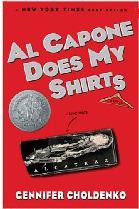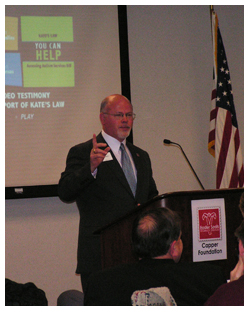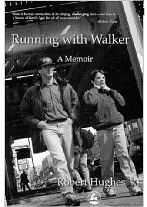by Beth Finke

I am happy to introduce Margo L. Dill, as a guest blogger. Margo is a columnist for WOW! Women On Writing, and writes a blog for teachers, parents, and librarians called Read These Books and Use Them. Her first book, Finding My Place, a middle-grade historical novel, will be published in 2009.
Book Review: Gennifer Choldenko’s “Al Capone Does My Shirts”
by Margo L. Dill
Moose Flanagan lives on Alcatraz Island because his dad is a prison guard. Gennifer Choldenko’s author’s note tells the reader that the staff did live on the island with their spouses and children. Al Capone Does My Shirts has a lot of accurate, fascinating history in it.
Back to the story. The Flanagans are a loving family, consumed by Moose’s sister, Natalie, who has autism. This book is much more about Moose and Natalie’s relationship than it is about Al Capone doing laundry, but the inmates are interesting characters in the story. Moose misses his old home and isn’t thrilled about living with the prisoners, but he learns to make the best of it, makes some friends, still plays baseball when he can, and has more responsibility for taking care of Natalie. He builds a special relationship with her, and his parents believe Moose is one of the reasons why Natalie is communicating more.
In the end, Moose writes a letter to Capone, asking him if there is any way the gangster can help Natalie get into this special school that will help her have a more independent future. Can Capone pull strings to get Natalie in when it seems no one else can?
So, what do I do with this book?
1. Your students can gather facts about the 1930s from this book. They can also research and find out what was happening in other parts of the United States during this period. They can compare and contrast life on Alcatraz Island with life in New York City or San Francisco or your hometown. Alcatraz Island also has a fascinating history. If students are interested in Alcatraz, they can research the prison and see if they can find more facts than Choldenko provided in her author’s note. They can add a paragraph or two to the author’s note.
2. Autism affects millions of people. You may have someone in your school or family who has autism. Talking about Natalie’s actions in the story might help students understand autism and why Natalie acted the way she did in certain situations. You could invite an expert in autism to your classroom to talk about all the current research and ways to help a student with autism that were not available in 1935. Students can write journal entries about the discussions you have about autism, about how it would feel to watch Natalie after school like Moose did, or about any questions or feelings they may still have.
3. Moose loves baseball, and Natalie loves her collection of buttons. Talk to your students about their hobbies or collections. Hold a “Hobby Day” in your classroom. Let students bring in items that they use in their hobbies, or they could bring in a part of their collections. Students could write paragraphs about their hobbies and draw pictures to go with them. Hobby Day allows classmates to see a different side of each other.
Overall rating of this book: Can you say WOW!?







 I started my morning last Wednesday with a visit to
I started my morning last Wednesday with a visit to 
